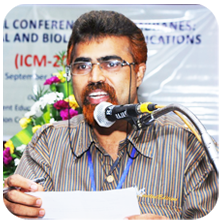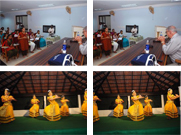School of Environmental Sciences
Priyadharshini Hills P. O
Athirampuzha
Kottayam, Kerala, India-686560
P +91 2732120, +91 9447 391 168
E cta@mgu.ac.in
F +91 481 271 009/02
Priyadharshini Hills P. O
Athirampuzha
Kottayam, Kerala, India-686560
P +91 2732120, +91 9447 391 168
E cta@mgu.ac.in
F +91 481 271 009/02
The International Conference on Membranes (ICM-2013)
on October 3rd to 6th2013
on October 3rd to 6th2013
International Conference on Frontiers of Mass Spectromerty (ICMS 2013)
on September 6th to 9th 2013
on September 6th to 9th 2013
Second International Conference on Advanced Oxidation Processes (AOP 2012)
on October 5th to 8th 2012
on October 5th to 8th 2012
CTA RESEARCH GROUP

School of Environmental Sciences and Dean,
Faculty of Environmental and Atmospheric Sciences,
Mahatma Gandhi University
Prof. C.T. Aravindakumar received B.Sc. degree in chemistry from University of Kerala in 1986 (D.B. College, Sasthamcotta). A national level fellowship (NCL-Pune University) brought him to University of Pune for doing M.Sc. in 1986. He completed M.Sc. in 1988 and joined for Ph.D. at the same year. The Ph.D. thesis work with the title, Radiation Chemical Studies of Some DNA Model Systems, is an interdisciplinary topic which has relevance in chemistry, biology and environment (under the guidance of Prof.B.S.M. Rao). This involved extensive use of Pulse Radiolysis. The programme was completed in collaboration with the Bhabha Atomic Research Centre (BARC), Mumbai (with Padma Shri Prof.J.P. Mittal and Dr.Harimohan) and the Max-Planck-Institute (MPI) fuer Strahlenchemie, Muelheim a.d. Ruhr, Germany (with Prof.von Sonntag). He was the recipient of ICSC-World Laboratory (Switzerland) fellowship to work at the MPI, Germany, as part of the Ph.D programme. During this tenure, he also collaborated with Tata Institute of Fundamental Research, Mumbai, for experiments on Laser-EPR for radical detection. Immediately after his Ph.D. from University of Pune, he joined as a Lecturer at the School of Chemical Sciences of Mahatma Gandhi University, Kottayam, in 1993. He established a research group mainly working on the free radical induced degradation of DNA model systems, and of organic water pollutants, using Fenton, photochemical and radiation chemical techniques.
Later he joined the Division of Biochemistry of Katholieke Universities Leuven, Belgium for post-doctoral research in 1997 to work on a two year programme on nitric oxide - protein interaction (with Prof. Mark DeLey and Prof.Coulemans). The selected protein was metallothionein extracted from human foetal liver. Another post-doctoral fellowship from Max-Planck-Society brought him back to Max-Plank-Institute f. Strahlenchemie in 2000 (with Prof. Von Sonntag). He also worked as a Visiting Faculty for one year at the Department of Biophysics of Vrije Universiteit Amsterdam, The Netherlands in 2001 (with Prof. Rienk van Grundelle and Prof. Herbert van Amerongen). During this period he worked in the field of Laser (femtosecond) spectroscopy related to charge transport in DNA. He also established several collaborative research and made research visits in international laboratories such as at the Environmental Engineering Division of the California Institute of Technology, USA (with Prof. M. Hoffmann), Department of Chemistry of Pohang University of Science and Technology, South Korea (with Prof. T. Joo), Radiation Biology Division of GSF-National Research Centre for Environment and Health, Germany (with Prof. Eckard Schupp), University of Paris (S) (with Prof. J. Belloni), Norwegian University of Science and Technology, Trondheim, Norway (with Prof. May-Britt-Haag) etc. He is recently selected as a Visiting Professor (full professorship) at the Laboratory of Geology & Environment, University of Paris-Est Marne-la-Valee, France. Nearly 20 of his selected invited talks outside India are in various Universities and Research Organizations in Germany, Netherlands, Belgium, Italy, France, USA, Japan, Thailand, Hong-Kong, and Korea. He joined as a Professor at the School of Environmental Sciences of Mahatma Gandhi University in 2010. He is presently the Dean of Faculty of Environmental and Atmospheric Sciences of Mahatma Gandhi University.
His research interests in the last two decades have been in radiation chemistry, environmental chemistry, radiation biology and photochemistry. More specifically, these include Advanced Oxidation Process for the degradation of Environmental Pollutants (Emerging Pollutants: pharmaceuticals and personal care products (PPCPs), pesticides, halobenzenes, toluenes etc), Membrane technology for water purification, Ultrasound and Cloud mimic reactions in pollutant degradation, air pollution, Radiation and Photo- induced modifications of DNA and related compounds, Nitric oxide-Protein/amino acid interaction, and Computer based theoretical calculations for free radical reactions (DFT). Polyelectrolyte multilayer membrane for biological and environmental applications (including energy), and photo catalysis are recent addition in the research interests. His publications in the last two decades appeared in Environmental science, Chemistry, Physics and Biomedical related journals, such as in Journal of Hazardous Materials, Water Research, Desalination, Colloids and Surfaces B: Biointerfaces, Chemical Physical Letters, Chemical Physics, Journal of Membrane Science, Chemical Communication, Journal of Physical Chemistry, Journal of Agricultural and Food Chemistry, Free Radicals in Biology and Medicine, Physical Chemistry Chemical Physics, Nitric oxide-Biology and Chemistry, Biophysical Journal , Organic and Biomolecular Chemistry, Journal of American Chemical Society, Biophysical Chemistry, Biochemical Journal, International Journal of Radiation Biology etc. He is also a constant reviewer of many international journals in environmental science, Chemistry and biology.
He completed four national and three international major research projects besides several ongoing projects. Research funding is mainly from DST, BRNS, ICTP, KSCSTE, and University of Paris (S) (under Indo-French Arcus programme), UGC etc. One of the major recent international programmes includes the Singh-Obama 21st Century Knowledge Initiative with Duke University, USA (with Prof.Mark Wiesner at the Centre for Environmental Impact of Nanotechnology).
Besides his research activities, he has interest in environmental education, environmental policies and governance, and music (sitar).
Later he joined the Division of Biochemistry of Katholieke Universities Leuven, Belgium for post-doctoral research in 1997 to work on a two year programme on nitric oxide - protein interaction (with Prof. Mark DeLey and Prof.Coulemans). The selected protein was metallothionein extracted from human foetal liver. Another post-doctoral fellowship from Max-Planck-Society brought him back to Max-Plank-Institute f. Strahlenchemie in 2000 (with Prof. Von Sonntag). He also worked as a Visiting Faculty for one year at the Department of Biophysics of Vrije Universiteit Amsterdam, The Netherlands in 2001 (with Prof. Rienk van Grundelle and Prof. Herbert van Amerongen). During this period he worked in the field of Laser (femtosecond) spectroscopy related to charge transport in DNA. He also established several collaborative research and made research visits in international laboratories such as at the Environmental Engineering Division of the California Institute of Technology, USA (with Prof. M. Hoffmann), Department of Chemistry of Pohang University of Science and Technology, South Korea (with Prof. T. Joo), Radiation Biology Division of GSF-National Research Centre for Environment and Health, Germany (with Prof. Eckard Schupp), University of Paris (S) (with Prof. J. Belloni), Norwegian University of Science and Technology, Trondheim, Norway (with Prof. May-Britt-Haag) etc. He is recently selected as a Visiting Professor (full professorship) at the Laboratory of Geology & Environment, University of Paris-Est Marne-la-Valee, France. Nearly 20 of his selected invited talks outside India are in various Universities and Research Organizations in Germany, Netherlands, Belgium, Italy, France, USA, Japan, Thailand, Hong-Kong, and Korea. He joined as a Professor at the School of Environmental Sciences of Mahatma Gandhi University in 2010. He is presently the Dean of Faculty of Environmental and Atmospheric Sciences of Mahatma Gandhi University.
His research interests in the last two decades have been in radiation chemistry, environmental chemistry, radiation biology and photochemistry. More specifically, these include Advanced Oxidation Process for the degradation of Environmental Pollutants (Emerging Pollutants: pharmaceuticals and personal care products (PPCPs), pesticides, halobenzenes, toluenes etc), Membrane technology for water purification, Ultrasound and Cloud mimic reactions in pollutant degradation, air pollution, Radiation and Photo- induced modifications of DNA and related compounds, Nitric oxide-Protein/amino acid interaction, and Computer based theoretical calculations for free radical reactions (DFT). Polyelectrolyte multilayer membrane for biological and environmental applications (including energy), and photo catalysis are recent addition in the research interests. His publications in the last two decades appeared in Environmental science, Chemistry, Physics and Biomedical related journals, such as in Journal of Hazardous Materials, Water Research, Desalination, Colloids and Surfaces B: Biointerfaces, Chemical Physical Letters, Chemical Physics, Journal of Membrane Science, Chemical Communication, Journal of Physical Chemistry, Journal of Agricultural and Food Chemistry, Free Radicals in Biology and Medicine, Physical Chemistry Chemical Physics, Nitric oxide-Biology and Chemistry, Biophysical Journal , Organic and Biomolecular Chemistry, Journal of American Chemical Society, Biophysical Chemistry, Biochemical Journal, International Journal of Radiation Biology etc. He is also a constant reviewer of many international journals in environmental science, Chemistry and biology.
He completed four national and three international major research projects besides several ongoing projects. Research funding is mainly from DST, BRNS, ICTP, KSCSTE, and University of Paris (S) (under Indo-French Arcus programme), UGC etc. One of the major recent international programmes includes the Singh-Obama 21st Century Knowledge Initiative with Duke University, USA (with Prof.Mark Wiesner at the Centre for Environmental Impact of Nanotechnology).
Besides his research activities, he has interest in environmental education, environmental policies and governance, and music (sitar).
Selected Publications
(Representative)
Home | Biography | Publications | Our Lab | News | Events | Erudite | SECAS | Research
Peoples | Collabrotions | Photos | Contact
Peoples | Collabrotions | Photos | Contact
| CTAMGU © 2012 | Design & Developed By : ITS Developers |


